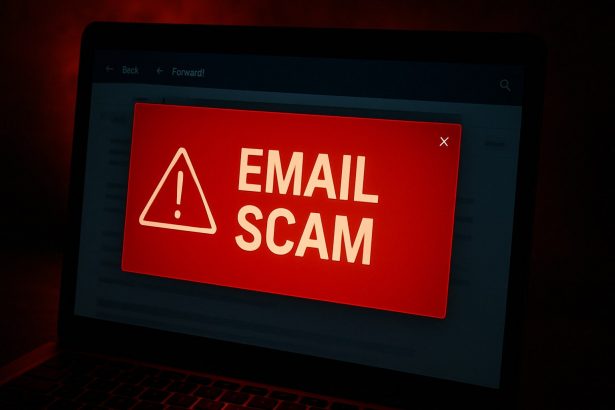Imagine opening your inbox and finding a message that claims to have your full search history and secretly recorded webcam footage. The email reads like a blackmail script—complete with a countdown and a Bitcoin address. One recent case involved a retired teacher who nearly wired $1,500 after receiving such a message, convinced her reputation was moments away from ruin. These sextortion scams aren’t just spam—they’re calculated psychological ambushes designed to coerce victims into paying up fast.
Threat Overview
This scam doesn’t rely on malware or technical hacks. Instead, it exploits fear, shame, and urgency. The attackers count on panic to override skepticism. The message might even include a real password harvested from an old breach, adding a chilling sense of authenticity.
In-Depth Analysis
Infection Vector
The message usually comes from a spoofed or compromised email account. No actual hacking is needed. Most victims are targeted through large-scale email lists obtained from past data breaches or dark web markets. These emails often feature dramatic subject lines like:
- “We have your webcam footage and search history”
- “Your secrets are about to be revealed”
The attacker tries to create instant dread. The moment the email is opened, the clock begins ticking—psychologically, if not literally.
Behavioral Profile
Here’s the typical pattern of these scams:
- Shock Setup – The email claims your device was hacked, camera activated, and private footage captured.
- “Proof” Layer – Often includes a leaked password to suggest deeper access.
- Ransom Demand – Usually demands Bitcoin, with a short deadline (24 to 72 hours).
- Threat of Exposure – Claims the footage will be sent to all your contacts.
- Payment Instructions – Includes a crypto wallet and warning not to contact authorities.
Some variants even track whether the email was opened, using invisible tracking pixels to reinforce the illusion of live surveillance.
Risk Assessment
This is a low-tech, high-impact social engineering attack. Despite the dramatic claims, very few reports involve actual data theft or unauthorized recordings. The real danger lies in the psychological warfare. In 2023 alone, hundreds of victims worldwide reported falling for similar sextortion emails, with total losses running into millions.
What makes this scam effective is its simplicity:
- No malware
- No need to breach systems
- Just fear, shame, and urgency
Anyone with a digital footprint—especially those with older leaked passwords—is a potential target.
Artifact Text
A real example might look like this:
Subject: We have your search requests and webcam footage
I am aware of your activities. You know what I mean. While you were browsing, I activated your webcam and recorded everything.
I have both your screen recordings and video of you.
To avoid embarrassment, send $950 in Bitcoin to the address below within 48 hours.
Address: 1HGaQxy87...kPZ
Don’t waste time. If you ignore this, I’ll send everything to your family, coworkers, and social media.
There are no second chances.How to Manually Identify and Remove Email Scams
Manually removing email scams involves recognizing fraudulent messages, securing your accounts, and taking precautions to prevent future attacks. Follow these steps:
Step 1: Identify Suspicious Emails
Before taking action, you need to identify scam emails. Common signs include:
- Unknown Sender: Emails from unfamiliar addresses, especially if they claim to be from banks, tech support, or government agencies.
- Urgency or Threats: Scammers often pressure you to act immediately (e.g., “Your account will be closed in 24 hours!”).
- Poor Grammar & Spelling: Many scam emails contain obvious grammatical mistakes.
- Suspicious Links & Attachments: Hover over links (without clicking) to check the actual URL. If it looks odd, don’t click.
- Requests for Personal Information: Legitimate companies will never ask for passwords, Social Security numbers, or credit card details via email.
Step 2: Do Not Click Links or Download Attachments
If you suspect an email is a scam:
- Do not click on any links.
- Do not open any attachments.
- Do not reply to the sender.
Step 3: Report the Email Scam
You can report the scam email to various authorities:
- Gmail/Outlook/Yahoo Users: Click the “Report Phishing” or “Report Spam” button in your email client.
- FTC (Federal Trade Commission, USA): Report to FTC Complaint Assistant.
- Google Safe Browsing: If the scam email contains a phishing website, report it here.
Step 4: Block the Sender
- Gmail: Open the email, click the three dots in the top-right corner, and select “Block [Sender Name]”.
- Outlook: Open the email, select “Junk” > “Block Sender”.
- Yahoo Mail: Open the email, click “More” > “Block Sender”.
Step 5: Check Your Accounts for Unauthorized Activity
If you accidentally clicked a link or shared sensitive information:
- Change your passwords immediately. Use strong, unique passwords for every account.
- Enable two-factor authentication (2FA). This adds an extra layer of security to your accounts.
- Check your banking statements for unauthorized transactions.
Step 6: Scan Your Device for Malware
Some email scams contain malware hidden in attachments or malicious links. Run a full system scan using built-in tools:
- Windows Defender (Windows 10/11):
- Go to Settings > Update & Security > Windows Security > Virus & Threat Protection.
- Click “Quick Scan” or “Full Scan”.
- Mac Users:
- Use Malwarebytes for Mac or another security tool.
Step 7: Adjust Your Email Security Settings
- Enable email filtering to reduce spam and phishing emails.
- Add a third-party spam filter such as Mailwasher or Spamihilator.
- Educate yourself and others on phishing techniques to avoid future scams.
How to Remove Email Scams Using SpyHunter (Automated Method)
For users who prefer an automated, foolproof method to remove threats linked to email scams, SpyHunter offers an advanced security solution. SpyHunter is an anti-malware tool designed to detect and remove phishing-related threats, spyware, Trojans, and other cyber threats. Follow these steps:
Step 1: Download SpyHunter
- Visit the official SpyHunter download page: Download SpyHunter
- Click on “Download” and save the installation file to your computer.
Step 2: Install SpyHunter
- Locate the downloaded file (SpyHunter-Installer.exe) and double-click to open it.
- Follow the on-screen installation instructions.
- After installation, launch SpyHunter.
Step 3: Perform a Full System Scan
- Open SpyHunter and navigate to “Malware/PC Scan”.
- Click “Start Scan Now” to begin a deep scan of your system.
- SpyHunter will analyze files, registry entries, and processes for any threats linked to email scams, phishing, and malware.
Step 4: Review and Remove Detected Threats
- Once the scan completes, SpyHunter will list all detected threats.
- Click "Fix Threats" to remove them.
- Restart your computer to complete the removal process.
Step 5: Enable Real-Time Protection
SpyHunter includes real-time protection features to help prevent future infections:
- Enable Active Guards: This monitors your system for malware in real time.
- Schedule Automatic Scans: Set up periodic scans to detect new threats early.
Step 6: Keep SpyHunter Updated
- Regularly check for updates to ensure SpyHunter detects the latest threats.
- To update SpyHunter, open the app and go to "Settings" > "Update", then click "Check for Updates".
Preventing Future Email Scams
Now that you've removed email scams, take proactive steps to prevent them in the future:
Use a Secure Email Provider
- Consider switching to a secure email provider like ProtonMail or Tutanota, which offer advanced encryption.
Be Cautious with Email Links
- If you receive an email with a suspicious link, verify the website’s legitimacy before clicking.
Avoid Public Wi-Fi for Sensitive Activities
- Scammers can use public Wi-Fi to intercept your data. Use a VPN when accessing email on public networks.
Regularly Change Your Passwords
- Update your passwords every few months, and never reuse old passwords.
Use Anti-Phishing Extensions
- Install browser extensions like Bitdefender TrafficLight or Avast Online Security to detect phishing links in real-time.
Email scams are a serious cyber threat that can lead to financial loss, identity theft, or malware infections. By following the manual removal steps, you can effectively identify and remove suspicious emails on your own. However, for advanced protection, using SpyHunter ensures a more thorough and automated approach to detecting and removing phishing-related threats.
Recommended Action
For a fast and efficient way to remove email scams and related malware, download and install SpyHunter now: Download SpyHunter
By staying informed and proactive, you can protect yourself from future email scams and online threats!
Conclusion
These sextortion scams don’t need technical finesse—they thrive on panic. They exploit human emotions, not system vulnerabilities. Victims can defend themselves not with software, but with clarity and caution. Here's how:
- Don’t panic. The claims are usually fake.
- Don’t pay. Paying marks you as a target for more attacks.
- Reset any compromised passwords. Especially if a real one was quoted.
- Enable multi-factor authentication. Adds a powerful layer of defense.
- Report the email. Use email client tools or forward to authorities.
- Educate others. One informed friend could stop another from becoming a victim.
Awareness and resilience are your best shields. If you receive such an email, remember: it’s a bluff—not a breach.




